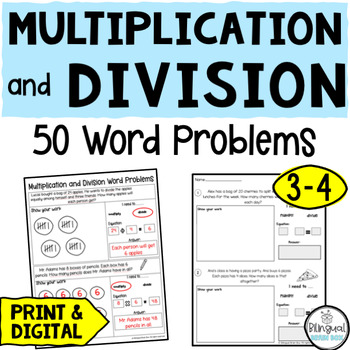Multiplication and Division Word Problems - Digital and Print - Equal Groups
Bilingual Brain Box
3.9k Followers
Grade Levels
2nd - 4th, Homeschool
Subjects
Resource Type
Standards
CCSS3.OA.A.1
CCSS3.OA.A.2
CCSS3.OA.A.3
CCSS3.OA.C.7
Formats Included
- PDF
- Google Apps™
Pages
37 + Digital Slides
Bilingual Brain Box
3.9k Followers

Includes Google Apps™
The Teacher-Author indicated this resource includes assets from Google Workspace (e.g. docs, slides, etc.).
What educators are saying
Thank you for creating a great straight forward resource. I have used this both online and in person.
This was an awesome resource. The kids loved using it on their Chromebooks and manipulating all the things.
Also included in
- This SUPER BUNDLE includes:50 word problems - Addition and Subtraction - Digital & Print50 word problems - Multiplication - Digital & Print50 word problems - Multiplication and Division - Digital & Print20 two-step word problems - All Operations with differentiated version - Digital &Price $17.25Original Price $27.65Save $10.40
Description
Multiplication and Division Word Problems - Digital and Print
This resource includes 50 multiplication and division word problems. Each problem requires students to circle the operation to solve the problem (multiplication or division), show their work with equal groups, write the correspondent equation, and write a solution sentence. This resource follows Third Grade standards but it can be used to reinforce concepts in fourth and fifth grade.
The preview video shows the digital version!
SUBSCRIBE to my newsletter to receive exclusive freebies and special announcements!
Total Pages
37 + Digital Slides
Answer Key
Included
Teaching Duration
N/A
Report this resource to TPT
Reported resources will be reviewed by our team. Report this resource to let us know if this resource violates TPT’s content guidelines.
Standards
to see state-specific standards (only available in the US).
CCSS3.OA.A.1
Interpret products of whole numbers, e.g., interpret 5 × 7 as the total number of objects in 5 groups of 7 objects each. For example, describe a context in which a total number of objects can be expressed as 5 × 7.
CCSS3.OA.A.2
Interpret whole-number quotients of whole numbers, e.g., interpret 56 ÷ 8 as the number of objects in each share when 56 objects are partitioned equally into 8 shares, or as a number of shares when 56 objects are partitioned into equal shares of 8 objects each. For example, describe a context in which a number of shares or a number of groups can be expressed as 56 ÷ 8.
CCSS3.OA.A.3
Use multiplication and division within 100 to solve word problems in situations involving equal groups, arrays, and measurement quantities, e.g., by using drawings and equations with a symbol for the unknown number to represent the problem.
CCSS3.OA.C.7
Fluently multiply and divide within 100, using strategies such as the relationship between multiplication and division (e.g., knowing that 8 × 5 = 40, one knows 40 ÷ 5 = 8) or properties of operations. By the end of Grade 3, know from memory all products of two one-digit numbers.






